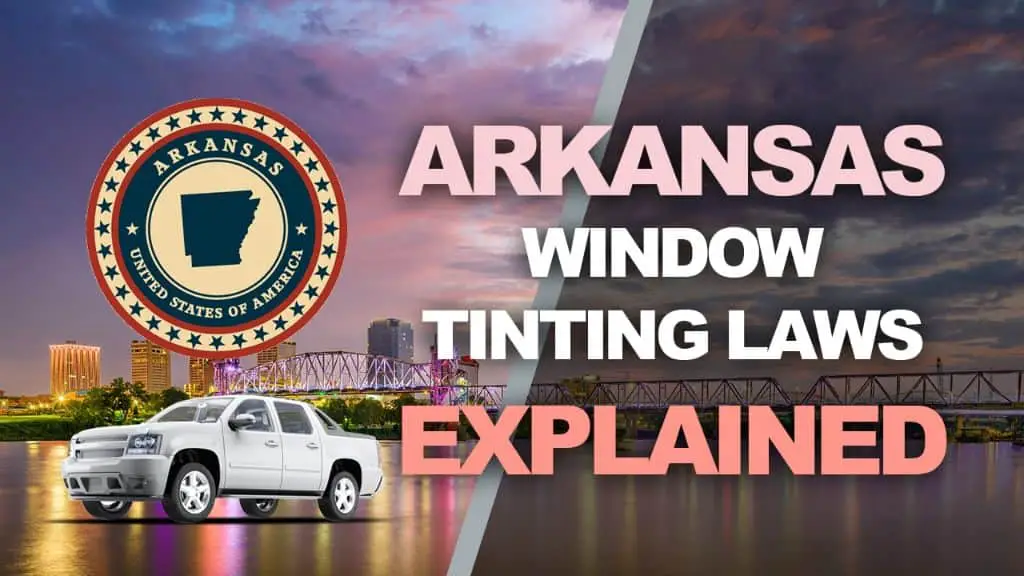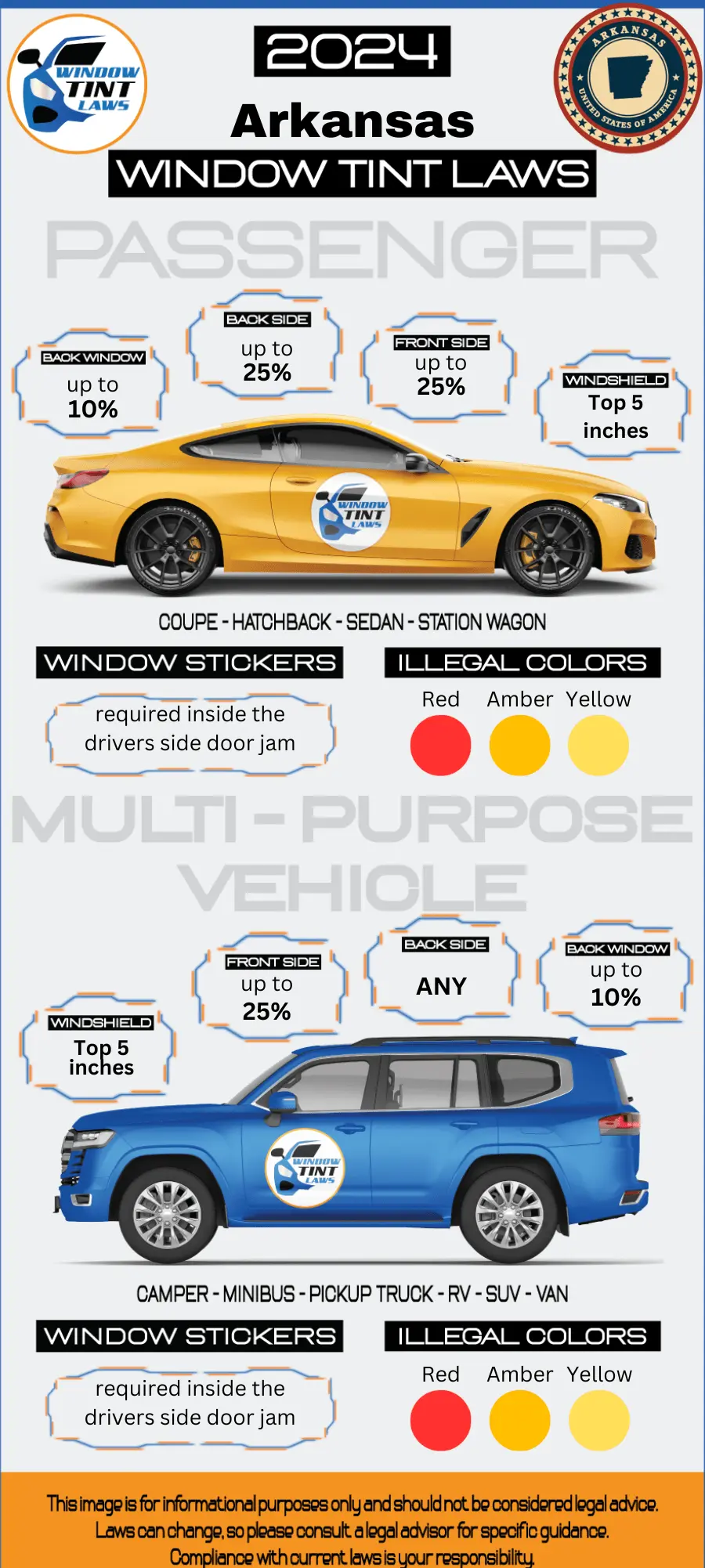

Article Created by Ryan Pietrzak
Last updated on February 2, 2024Arkansas Tint Laws – 2024 Updated Legal Tint Limit
Please note that Arkansas Tint Laws Regulation can change daily and may be interpreted differently at the city or county level. We recommend verifying this information with your local DMV or law enforcement agencies. We have manually fact-checked this content using official state resources. Arkansas enacted tinting laws in 1996. If any information provided is incorrect or outdated, please contact us so we can make the necessary corrections. Thank you.
2024 Arkansas Tint Laws – Legal Tint Limit For Passenger Vehicles
- Front Windshield: Non-reflective tint is allowed on the top 5 inches of the windshield. Non-reflective tint is allowed above the manufacturer’s AS-1 line. No tint is allowed below the AS-1 line.
- Front seat side windows: up to 25% tint darkness allowed. Must allow at least 25% of light transmission. This means tint can block up to 75% of light.
- Back seat side windows: up to 10% tint darkness allowed. Must allow at least 90% of light transmission. Tint can block up to 10% of light.
- Rear window: up to 10% tint darkness allowed. Must allow at least 90% of light transmission. Tint can block up to 10% of light.
2024 Arkansas Tint Laws – Legal Tint Limit For Multi-Purpose Vehicles
- Front Windshield: Non-reflective tint is allowed on the top 5 inches of the windshield.
- Front seat side windows: up to 25% tint darkness allowed
- Back seat side windows: Any tint darkness can be used
- Rear window: up to 10% tint darkness allowed

- Medical exemptions: Arkansas tint laws permit darker tints on front side windows with a doctor’s note
- Arkansas tint laws prohibit metallic or reflective tint on any of the windows
- Arkansas tint laws are statewide with no additional local regulations
- Violating Arkansas tint laws can carry a maximum $100 and/or 10 days in prison for first conviction. Second conviction within a year max $200 and/or 30 days in jail. Third and subsequent offense within a year $500 and/or up to 3 months in prison.
What does VLT Mean according to Arkansas Tint Laws?
- Window tint film’s light transmission is measured as VLT (Visible Light Transmission) and each state has its own legal limits for VLT on car windows.
- A HIGHER VLT means that more light is allowed to pass through the window tint film.
- Example: a 75% tint will allow 75% of the light to pass through whereas a 5% tint will only allow 5% of the light to pass through, making the 5% tint a much darker film.
- Arkansas window tint laws has specific VLT limits for Passenger Vehicles and Multi-Purpose Vehicles.
FAQ’s Regarding Arkansas Tint Laws and Arkansas Legal Tint Limit
What is the darkest legal tint in Arkansas?
In Arkansas, the darkest legal window tint for front side windows is usually 25% VLT (Visible Light Transmission), which means that at least 25% of light must pass through the window. However, it’s essential to verify the specific tinting laws and regulations with local authorities or the Arkansas State Police
Are police exempt from window tint laws in Arkansas?
In Arkansas, law enforcement vehicles are typically exempt from window tint laws, allowing them to have tinted windows that may be darker than what is legally allowed for civilian vehicles. However, the extent of this exemption can vary, so it’s advisable to check with local authorities or the Arkansas State Police
How do I get a tint waiver in Arkansas?
To obtain a tint waiver in Arkansas, you usually need to have a valid medical condition that requires special window tinting for medical reasons. You must obtain a medical certificate from a licensed physician, specifying the need for window tint due to your condition. Once you have the medical certificate, you can typically apply for a tint waiver through the Arkansas State Police or the relevant state agency responsible for handling tint exemptions.
How much is a tint ticket in Arkansas?
The cost of a tint ticket in Arkansas can vary depending on the specific violation and location. Fines for window tint violations typically range from around $100 to $200 or more. The exact amount may depend on factors such as the darkness of the tint and whether it’s a first-time or repeat offense.
How often are Arkansas tint laws updated?
Arkansas tint laws and regulations can be updated periodically as needed by the state legislature or relevant authorities. The frequency of updates can vary and may depend on factors such as changes in technology, safety concerns, or legislative decisions.
How to get a Tint Exemption in Arkansas
Arkansas State Law allows window tint medical exemptions to be given to vehicle owners. To file for a medical exemption in Arkansas you will need a letter stating the medical necessity for darker window tints that is signed by a licensed physician. If your physician determines it is in your best interest to be exempt from Arkansas Window Tint Laws for diseases and disorders, including, but not limited to, albinism or lupus, you can file an exemption.
You are required to carry the physical medical exemption certification with you at all times in your vehicle. Medical exemptions in Arkansas are valid for 3 years after the date in which they are issued.
The Medical Exemption in Arkansas allows you to tint your windows to the following percentages:
- Windshield can have 50% tint
- Side windows can have 20% tint
- Rear windows can have 10% tint
For more information regarding window tint medical exemptions in Arkansas, you can check these resources:

Ryan Pietrzak
Creator of Windowtintlaws.us
